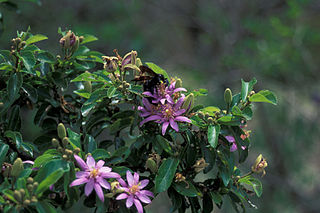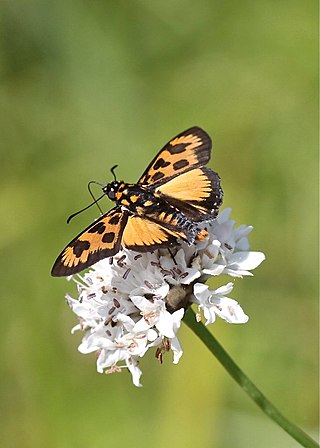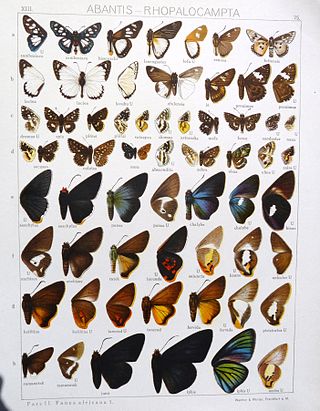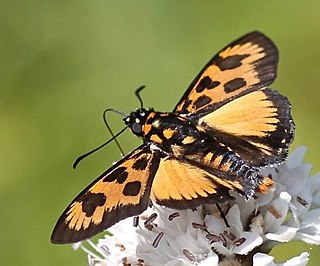
Grewia is a large flowering plant genus in the mallow family Malvaceae, in the expanded sense as proposed by the Angiosperm Phylogeny Group. Formerly, Grewia was placed in either the family Tiliaceae or the Sparrmanniaceae. However, these were both not monophyletic with respect to other Malvales - as already indicated by the uncertainties surrounding placement of Grewia and similar genera - and have thus been merged into the Malvaceae. Together with the bulk of the former Sparrmanniaceae, Grewia is in the subfamily Grewioideae and therein the tribe Grewieae, of which it is the type genus.

Dombeya rotundifolia, the dikbas or "South African wild pear", is a small deciduous tree with dark grey to blackish deeply fissured bark, found in Southern Africa and northwards to central and eastern tropical Africa. Formerly placed in the Sterculiaceae, that artificial group has now been abandoned by most authors and the plants are part of an enlarged Malvaceae.

Dombeya is a flowering plant genus. Traditionally included in the family Sterculiaceae, it is included in the expanded Malvaceae in the APG and most subsequent systematics. These plants are known by a number of vernacular names which sometimes, misleadingly, allude to the superficial similarity of flowering Dombeya to pears or hydrangeas. Therefore, the genus as a whole is often simply called dombeyas. The generic name commemorates Joseph Dombey (1742–1794), a French botanist and explorer in South America, involved in the notorious "Dombey affair", embroiling scientists and governments of France, Spain, and Britain for more than two years.

Palpita vitrealis, common name jasmine moth or white pearl, is a species of moth of the family Crambidae.

Abantis is an Afrotropical genus of skipper butterflies. They are also known as the paradise skippers. Their imagos are generally attractive with bold or colourful wing and/or body markings. They occur in either forest or savanna, and several species are very localized or thinly distributed. The territorial males are encountered more often than the females. Males engage territorial intruders, and are prone to very rapid and high flight, while females display more relaxed flight habits, closer to the ground. Plants of several families serve as food plants, and only one egg is oviposited per plant. The larva is pale and spotted to varying degrees, and pupates inside a leaf shelter drawn together by silk threads.

Tagiades flesus, the clouded flat, clouded forester or clouded skipper, is a butterfly of the family Hesperiidae from southern Africa.

Eagris nottoana, also known as the rufous-winged flat or rufous-winged elfin, is a species of butterfly in the family Hesperiidae. It is found from South Africa to Uganda, Kenya and Ethiopia, and on Madagascar.

Netrobalane canopus, the buff-tipped skipper, is a butterfly of the family Hesperiidae. It is found in savannah in Africa, from South Africa to Kenya to Nigeria and southern Sudan.

Leucochitonea levubu, the white-cloaked skipper, is a butterfly of the family Hesperiidae. It is found from Botswana to the former Transvaal and to Zimbabwe. The habitat consists of dry savanna.

Abantis tettensis, the spotted velvet skipper, is a butterfly of the family Hesperiidae. It is found in South-West Africa, Botswana, Transvaal, northern Cape, from Zimbabwe to Zaire and in Kenya.

Abantis bicolor, the bicoloured skipper, is a butterfly of the family Hesperiidae and the subfamily Pyrginae. Described in 1864 and endemic to South Africa, the bicoloured skipper is restricted to lowland forests from the Eastern Cape to the southern and northern coasts of KwaZulu-Natal.

Abantis paradisea, the paradise skipper, is a butterfly of the family Hesperiidae. It is found in KwaZulu-Natal, Zululand, Transvaal, Eswatini, Zimbabwe and from Botswana to Somalia.

Abantis venosa, the veined skipper or veined paradise skipper, is a butterfly of the family Hesperiidae. It is found in Zululand, Eswatini, Transvaal, Zimbabwe, Kenya and Uganda.

Grewia occidentalis, the crossberry, is a species of deciduous tree, indigenous to Southern Africa.

Lophostethus dumolinii is a moth of the family Sphingidae. It is known from most habitats, except desert and high mountains throughout the Ethiopian Region, excluding Madagascar and the Cape in South Africa.

Eagris sabadius is a species of butterfly in the family Hesperiidae. It is found in Uganda, Kenya, Tanzania, Malawi, Zambia, Zimbabwe and on Madagascar, Mauritius, Réunion, the Seychelles and the Comoro Islands. The habitat consists of montane forests, forests and forest margins.
Abantis adelica, the western ragged skipper, is a butterfly in the family Hesperiidae. It is found in Senegal, Burkina Faso, Guinea, Ghana, Togo, northern Nigeria, north-western Kenya, the Democratic Republic of the Congo (Shaba), Malawi and possibly southern Sudan, Ethiopia and Uganda. The habitat consists of Guinea savanna.
Abantis cassualalla, the Kavango skipper, is a species of butterfly in the family Hesperiidae. It is found in Angola and northern Namibia. The habitat consists of very dry savanna.

Anaphe reticulata, commonly known as the reticulate bagnest or reticulate bagnet, is a moth of the family Notodontidae which is native to savannah in sub-Saharan Africa. It was described by Francis Walker in 1855. It has been recorded from Angola, Eritrea, Ivory Coast, Malawi, Mozambique and South Africa. In southern Africa it is described as common and widespread. Anaphe panda is similar in appearance and habits.













